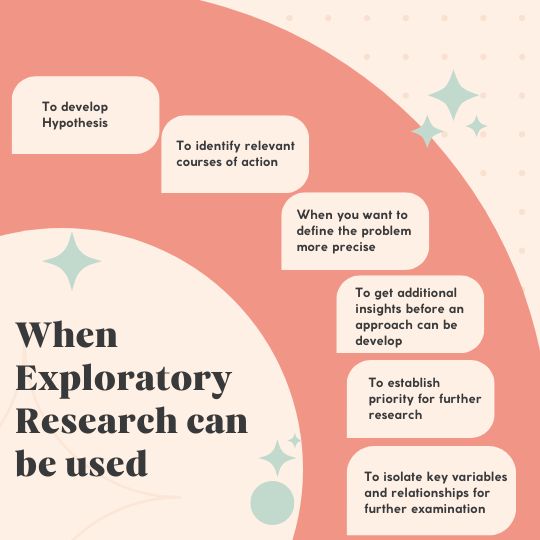Introduction to Exploratory Research: Techniques and its Evaluation
In this article we will go through the topic Explorative Research: Techniques and its Evaluation. Exploratory research design is a method used to investigate something new when there’s not much information available. It’s like taking small steps to understand a topic better before diving deep. By asking questions and gathering data, researchers can uncover initial insights and formulate further research questions.
When Exploratory Research Can be used?

1. Defining the Problem Precisely
Exploratory research helps to clearly understand and define a problem before diving deep into solutions, ensuring a solid foundation for further investigation.
2. Identifying Actionable Options
It assists in recognizing possible actions amidst uncertainty, guiding decision-making towards effective solutions.
3. Developing Hypotheses
By exploring various angles, it aids in forming educated guesses or hypotheses, paving the way for further testing and validation.
4. Gathering Additional Insights
Exploratory research gathers extra information, providing valuable insights to refine approaches and strategies.
5. Establishing Research Priorities
It assists in determining which areas warrant further attention, optimizing resources for maximum impact and efficiency.
6. Isolating Key Variables and Relationships
Like uncovering puzzle pieces, it identifies essential factors and connections for deeper analysis and understanding.
Read Also : Research Design
Exploratory or Formulative Research Techniques and its Evaluation
Exploratory or Formulative Research are used for conducting the research study in a proper system and order. Under such a design, following methods are used for collecting necessary basic material in connection with the problem under investigation
1. Study of Related Literature
As a first step towards constructing research design, the researcher should study published and unpublished literature related to the subject of research. Such material includes books, research journals, reports, articles papers and other documents. By doing so, one gets knowledge of the work already done so far in the field and the areas which can be studied further. The study of related material gives the researcher an insight into the topic and a clear perspective of his task ahead.
2. Experience Survey
It is a different type of survey which aims at obtaining the data and information from such people who, on the basis of their experience, possess authentic and valuable knowledge on the subject of research but are not willing to come forward to share such knowledge. It may be due to their old age or lack of formal education or any other reason. However, it is very useful for the researcher to identify such persons, contact them and obtain necessary information.
Such information should be collected preferably by personal interview and should be analyzed and explained properly. It is not an easy job but is very useful. This should be attempted quite carefully with due care and caution because some of such people may have their personal prejudices which, if not understood, may vitiate the result of research work. Experience survey saves time and money since it involves direct contact with respondents. The information and data so received through such a survey may provide new direction to the research work.
3. Selection of Respondents
The success of research design largely depends on proper selection of respondents who can provide appropriate, relevant, reliable and correct information. The researcher should select persons who are working in the area concerning the subject matter of research. They may be field workers, officials, social workers, public representatives and intellectuals. If the problem undertaken for study under exploratory research is related to rural area, then Ward Panchs, Sarpanchs, leaders of different segments of rural society and office bearers, rural workers and such other persons should be selected as respondents.
There are many educational institutions such as government and private schools and non- government organizations (NGOs) working in almost all villages. The people working in these organizations (viz. headmasters, teachers, workers etc.) may also contribute valuable knowledge and information for the research work so they may also be contacted and their views, opinion and experience may be recorded.
4. Asking Right Questions
While preparing the questionnaire care should be taken to include only relevant questions. These questions should be worded in simple language. It should be ensured that none of the questions hurts feelings and sentiments of the people nor do they cause any embarrassment to the respondents. The questions should be asked in a proper sequence and order. Proper care and caution in selecting the questions will yield good material for study and analysis.
5. Analysis of Insightful Cases
Collection, classification and analysis of insightful events and cases is very important in research work. However, it may be observed that these events have direct bearing on the subject matter of research. Such events help in enriching the knowledge of researcher and throw light on all aspects of the problem. Through these events, he would be able to learn certain things which would not come to his knowledge in a routine study. This type of cases leads to a successful research investigation.
Functions of the Exploratory Research
The important functions of exploratory research design are as follows
1. The exploratory research design provides necessary experience for pursuing the research work in a systematic and disciplined manner.
2. It draws the attention of the researcher towards important issues and problems concerning his research work.
3. It develops new fields of study for research and brings the researchers in contact with insight stimulating cases and events.
4. It helps in testing the hypotheses.
5. It provides basic material for preparing the plan and format of research design.
6. It helps in finding the applicability and utility of various methods and techniques which are appropriate for pursuing the research study at hand.
7. It helps in developing the areas of research design by providing core material.
8. It gives proper direction to the research work by providing necessary relevant data, information and other material.
9. It motivates the researcher by creating his interest and attraction towards the subject matter of research and its study in depth and detail.
Conclusion of Exploratory Research: Techniques and its Evaluation
Exploratory research is a versatile tool, helping to define problems, generate ideas, and prioritize actions. Its methods, including interviews and observations, gather valuable insights, guiding decision-making. It serves as a preliminary step, illuminating paths forward amidst uncertainty, fostering understanding, and enabling effective problem-solving.


2 thoughts on “Exploratory Research: Techniques and its Evaluation”